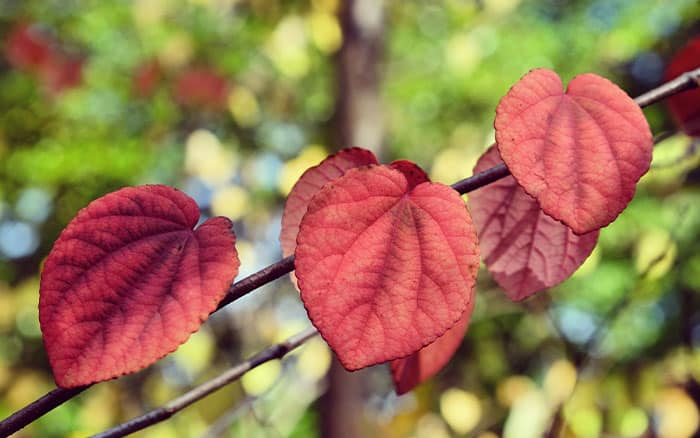By the start of October 2024, the weather has firmly shifted from late summer to autumn. And the days bring a profusion of colour as many shrubs and trees start to turn majestic fiery shades. There are also perennial plants that love to show off their flowers at this time of year. Here are ten of the best you wouldn’t want to be without in your garden…
1. Cercidiphyllum japonicum (Toffee apple tree)
Have you ever walked in a garden or park in autumn and smelt a lovely burnt sugar aroma in the air? If so, chances are there’s a Cercidiphyllum nearby and, at this time of year, they pump out this sweet smell.

- Flowers from September to November
- Hardy
- Grows to 45cm tall and 15cm wide
- Well-drained soil
- Full sun
- Sheltered
2. Sedum telephium (Atropurpureum Group) ‘Xenox’ (Ice Plant)
Sedums are, by and large, very easy, undemanding plants to grow. Plus, they attract a host of October 2024 pollinating insects when in flower. The flowers are produced on strong stems which, when dry, give structure to the winter border. Especially when frost or snow-covered. ‘Xenox’ clumps up into attractive, low-growing mounds of evergreen, deep, purple-leafed plants. These look good year-round and produce mounds of tiny, red flowers from August until October.

- Flowers from August to October
- Hardy
- Grows to 30cm tall and 30cm wide
- Well-drained soil
- Full sun
- Exposed
3. Rhus typhina (Stag’s horn sumach)
This deciduous shrub is prized for its finely cut, dark green leaves. However, those leaves also turn spectacular shades of red-orange during the autumn months. There is a bonus of deep red, cone-shaped looking flowers that are berries. It looks great planted as a specimen plant but beware, it will spread by suckers. Therefore, you may have to remove them as and when they appear. Alternatively, surround its roots with a non-perishable barrier when planting, to limit its spread.

- Flowers from June to August
- Hardy
- Grows to 500cm tall and 600cm wide
- Well-drained, moisture retentive, moderately fertile soil
- Full sun
- Sheltered
4. Stipa calamagrostis (Stoke’s aster)
The medium size height and habit of this grass make it ideal for integrating into a flower border. Its thick tufts of fine leaves and fountains of long-lasting, elegant, white flowers will perfectly complement late-summer flowering plants.

- Flowers from June to October
- Hardy
- Grows to 90cm tall and 75cm wide
- Well-drained soil in a warm spot
- Full sun
- Exposed
5. Ageratina altissima ‘Chocolate’
This upright, bushy plant will flower long after most others have gone over. The white flowers bunched together forming small, fluffy-looking balls on long, flower stalks appearing from deep purple-brown leaves.

- Flowers from August to October
- Hardy
- Grows to 90cm tall and 75cm wide
- Moist soil
- Full sun or part shade
- Exposed
6. Rudbeckia triloba (Black-eyed Susan)
Cheerful, rich-yellow, daisy flowers cover this plant for weeks on end come late summer. Airy, upright and easy to grow, it’s an invaluable source of late summer colour in the flower border.

- Flowers from August to October
- Hardy
- Grows to 90cm tall and 75cm wide
- Well-drained soil
- Full sun
- Exposed
7. Succisa pratensi (Devil’s bit scabious)
A beautiful, long flowering plant, attractive to butterflies and bees, and striking in an informal planting mix or wildflower meadow. Its deep, lilac-blue, ball-shaped flowers look like mini pom-poms and are light and airy in appearance. Wonderful in October 2024 gardens.

- Flowers from July to October
- Hardy
- Grows to 120cm tall and 90cm wide
- Well-drained soil
- Full sun or part shade
- Exposed
8. Euonymus alatus (Fire bush)
It’s easy to see at this time of year where this deciduous, bushy, shrub got its common name from! The leaves turn a brilliantly bright red so is best planted where the sun catches and highlights the vivid leaves.

- Flowers from May to June
- Hardy
- Grows to 45cm tall and 15cm wide
- Moderately fertile, well-drained, moisture-retentive soil
- Full sun
- Exposed
9. Cornus sanguinea ‘Anny’s Winter Orange’ (Dogwood)
Many different cultivars of dogwood come into their own now, leaves turning to different shades of yellow, orange and red. Revealing coloured stems as they fall, they are a great choice to brighten up the autumn/winter garden. Anny’s Winter Orange is one of the best of them for autumn leaves and striking October 2024 and winter colours. Its orange-red flushed stems will also tolerate most soil conditions.

- Flowers from September to November
- Hardy
- Grows to 250cm tall and 250cm wide
- Moist, well-drained soil but will also tolerate poorly drained soil too
- Full sun or part shade
- Exposed
10. Acer palmatum ‘Autumn Red’ (Japanese maple)
The clue to this tree is in its name! A small, bushy tree which produces dainty, light green leaves in the spring which turn fiery crimson in the autumn. Japanese maples need a partly shaded, sheltered spot as, too windy and open a location will scorch the leaves. They make great specimen trees, especially for a courtyard or smaller garden.

- Flowers from April to May
- Hardy
- Grows to 250cm tall and 250cm wide
- Well-drained, moderately fertile, moisture-retentive soil
- Part shade
- Sheltered

Leave A Comment